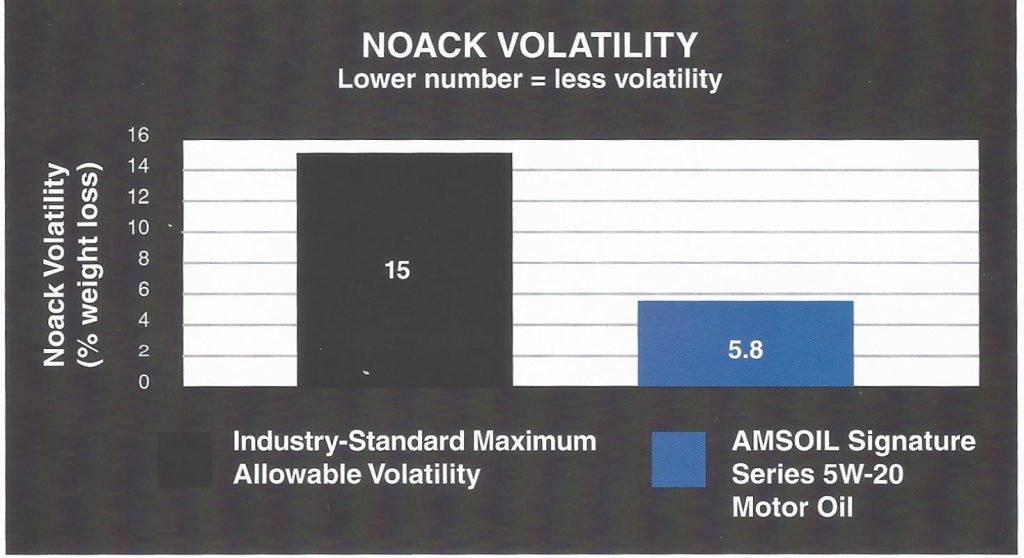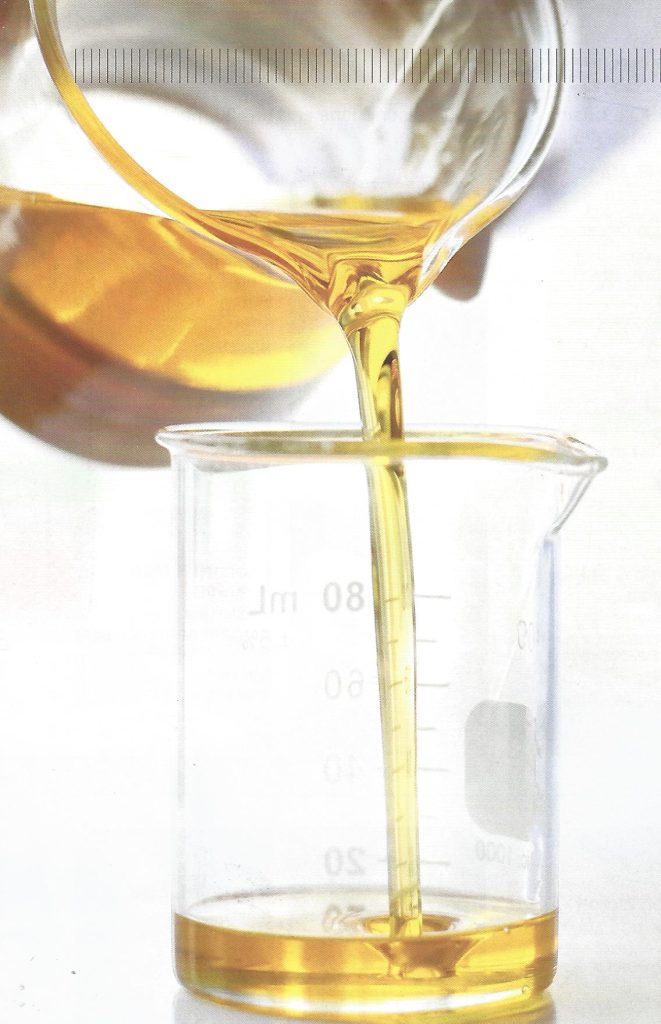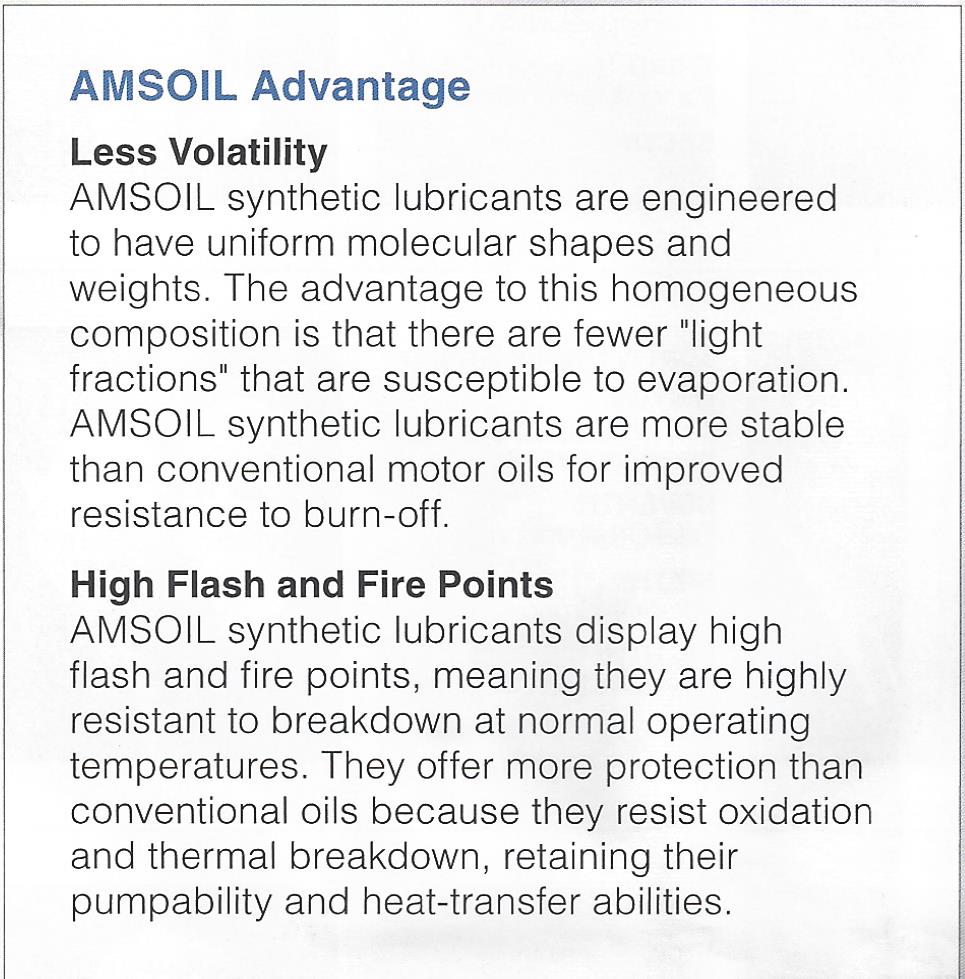Volatility is the property that defines a lubricant’s evaporative loss. The more volatile a lubricant, the lower the temperature at which it begins to evaporate. The more it evaporates, the less oil is left to protect equipment and the faster a user must replace the lost oil.
The small, light molecules in conventional lubricants evaporate at relatively low temperatures. These light
molecules require less energy in the form of heat than heavier molecules to be lifted out of the solution and into the air. The tendency of a liquid to evaporate is referred to as volatility.
Why is Volatility Important?
Volatility affects more than the rate of oil consumption. When light elements in oil evaporate from heat, the oil’s viscosity increases. This thicker oil forces the engine to work harder, resulting in several problems:
- Performance loss
- Fuel-economy loss
- Poor cold-temperature starting
- Increased engine deposits
Because volatility causes oils to thicken with use, oil becomes harder to pump. Pumps that must move thicker oil wear more quickly and consume more energy.
Parts require more energy to move through thicker oil than they do in thinner oil. As a result, extra energy is spent on pumping and moving through thick oil, reducing performance and fuel economy.
Noack Volatility Test (ASTM 05800)
The most common method used in measuring oil volatility is the Noack Volatility Test. In this test, an oil sample is weighed and then heated to a temperature of 482°F (250°C) for one hour. During this time, dry air is passed over the sample, which carries off the oil vapors that have boiled off and deposits them in a beaker attached to the apparatus. Finally, the original sample is removed and re-weighed. Any reduction in weight is reported as a percentage loss of the original weight. The entire procedure is similar to the operation of a petroleum fractioning tower or still.
API SP and ILSAC GF-6 performance classifications require volatility weight loss be no greater than 15 percent for all viscosity grades.

Understanding Flash and Fire Points
Flash and fire points help describe a lubricant’s high-temperature performance and stability.
The flash point is the lowest temperature at which the vapor above an oil sample ignites when a flame is passed over it. Once the flame on the surface of the oil continues to burn for at least five seconds after the ignition flame has been removed, the temperature is recorded as the oil’s fire point. Fire points are generally higher than flash points by 10°F to 40°F (S.6°C to 22.2°C). An additional classification, the auto-ignition point, is the temperature at which oil ignites on its own without the aid of an outside ignition source.


It’s important to note that flash and fire points should not be used to ascertain an oil’s usable temperature range. This range is typically 100°F to 150°F (37.8°C to 65.5°C) lower than reported flash- and fire-point values.
Flash and fire points can be significantly different between lubricants. Some lubricants have a relatively small temperature range among flash, fire and auto-ignition points, while others have a significantly larger range. Oils that are more stable tend to have flash and fire points that are higher and closer together than oils that are more volatile.
Conventional lubricants often contain chemicals that break down at normal operating temperatures. The presence of oxygen increases the likelihood of chemical breakdown, and oxygen can be found in almost all vehicle and equipment systems.
When contaminants in conventional oils break down, they deposit sludge and varnish on component surfaces, which leaves the oil thick and hard to pump. Oil that has broken down also has little heat-transfer capability.
High flash and fire points tend to suggest improved high-temperature stability, which reduces oil consumption and increases the oil’s service life.
The Cleveland Open Cup Test (ASTM 092)
The Cleveland Open Cup Test (ASTM D92) measures motor oil flash and fire points. This test is intended for fluids having a flash point of 175°F (794°C) and above. A fixed volume of fluid is heated at a uniform rate while open to the atmosphere at its surface. A small flame is passed over the surface at uniform temperature increments to determine the point at which vapors ignite. This temperature is recorded as the oil’s flash point. At a somewhat higher temperature, self-sustained burning for at least five seconds determines the fire point.

*All trademarked names and images are the property of their respective owners and may be registered marks in some countries. No affiliation or endorsement claim, express or implied, is made by their use. All products advertised here are developed by AMSOIL for the use in the application shown.
Reproduced With The Permission Of AMSOIL INC. All Rights Reserved.
Data Sheets for
- Gasoline Engine Oils
- AMSOIL Signature Series Synthetic Oils
- AMSOIL XL Series Synthetic Oils
- AMSOIL OE Series Synthetic Oils
- AMSOIL European Synthetic Oils*
- Diesel Engine Oils
- AMSOIL Signature Series Max-Duty Synthetic Diesel Oils
- AMSOIL Heavy Duty Synthetic Diesel Oils
- AMSOIL Synthetic Diesel Oil For Smaller Diesel Engines
*AMSOIL European Synthetic Oils meet the requirements for both gasoline and diesel engines depending on the specification. See one of the guides listed below for your specific vehicle.
Not sure which oil is right for your application? Use the AMSOIL Product Guide to find the recommended products for multiple types of vehicles and equipment. For Auto/Light Truck lookup, this guide will give you more detail.
For more information or pricing on the quality line of AMSOIL Products contact SLS Associates. Whether you are a Consumer, Retailer, or Commercial Business, we will answer your questions, explain any options and you take it from there. If you choose to try AMSOIL products we will give you our best price and you make the decision. No pressure. It’s your choice.
Click Here if you would like to browse the current AMSOIL Catalog
